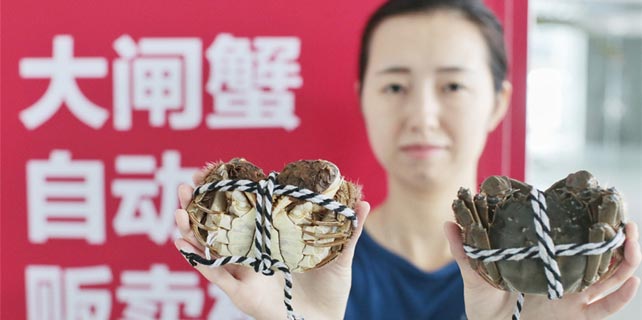Disney opens doors for Chinese animation filmmakers
 |
|
A child plays in front of a wall presenting Disney figure Mickey at the Walt Disney 90th Anniversary Exhibition in Indigo Department Store in Beijing, Sept 6, 2014.[Photo/Xinhua] |
As the first US-China social and people-to-people dialogue kicks off on Thursday in Washington D.C., Walt Disney Studios did its own bit by hosting a cross-cultural dialogue of its own.
The five-day, intensive Disney-China Animation Exchange Program, supported by China Film Bureau, was tailored to suit the needs of an elite cadre of Chinese animation filmmakers.
Celebrating its third year, the program, which concluded Wednesday, was a high-level exchange of ideas and practices between filmmakers of Walt Disney Animation Studios and the leading animation filmmakers from China.
"Walt Disney Animation Studios is deeply honored to open our doors and share our learnings and best practices with China's local creative industry. These exchanges have been inspiring to all of us involved," said Andrew Millstein, president of Walt Disney Animation Studios.
"It's an opportunity to exchange ideas and share our approaches to filmmaking, production, marketing, distribution and our underlying concept of how to create a healthy and vibrant studio," Millstein told Xinhua.
Shujie Li, founder of Chengdu L Square Culture Communication Co and one of the 14 program participants from China, said "It's great for Chinese and American filmmakers to exchange ideas face-to-face and to deepen our understanding and friendship with each other so we can carry out more exchanges and cooperation in the future."
The exchange program was the brainchild of John Lasseter,chief creative officer of Walt Disney and Pixar Animation Studios and the creative force behind Disney's global winning streak.
During a publicity tour through China for "Big Hero 6," Lasseter was repeatedly asked whether Disney would open a facility in China to help take Chinese animation to the next level.
Lasseter decided to institute the Exchange Program in cooperation with China's Film Bureau in order to share Disney's secrets of success with Chinese animators so they could create their own successful studios.
An indication of the level of respect Disney accorded this unique Chinese exchange program is that the seminar speakers included such top-ranking creative and executive powerhouses as John Lasseter, Pixar co-founder and president of Walt Disney and Pixar Animation Studios, Ed Catmull, president of Walt Disney Animation Studios, Andrew Millstein, head of Production, Ann Le Cam, and Academy Award-winning producer, Roy Conli, as well as other top producers, writers and directors.
Andrew Millstein and Ann Le Cam, speaking on Studio Leadership, welcomed the Chinese participants. "It's an honor to host our friends from China. This exchange helps us strengthen relationships and share in a way that elevates the animation industry as a whole."
"It's exciting to closely observe Disney studios. It makes us ponder the gap between Chinese animation studios and Disney, the world's leading animation studio. Not only in facilities and hardware, but also in ideas and creativity," said Zhigang Yang of Shanghai Pic-moment Film Corporation.
Ann Le Cam told Xinhua that, "Our winning formula is simple: everyone under one roof, open communication, and freedom to innovate."
Millstein agreed, "We invest a lot of time, effort and money into our talented people to enable them to put their highest potential on the screen. You have to support the artists' visions and give them the tools they need to create great stories."
The legendary Lasseter conducted a masterclass on Risk Taking and Innovation and riveted the participants with an in-depth overview of his and the studio's creative process, with a sprinkling of career advice and personal anecdotes.
"Trust your instincts, your taste, and experience when making creative decisions," he advised.
Lasseter outlined his simple recipe for making successful films, "I look for three things in a great project, a compelling, unpredictable story; appealing and memorable characters; and a unique world or setting."
He encouraged his visitors to keep technology and artistic creativity in balance. "Art challenges tech and tech inspires art. It's a collaborative Yin and Yang."
Academy Award-winning producer Roy Conli premiered his team's latest effort, "Olaf's Frozen Adventure," a short film based on Disney's runaway hit "Frozen" and its characters.
"When you have a success like 'Frozen', keeping it alive with new material is a good thing. This short is meant to be a gift to the audience," he said.
The 20-minute film is indeed "a good thing" - a charming, musical tale about the true meaning of family, friendship and tradition, delivered with Disney's incomparable mixture of humor, heart and a hit soundtrack.
"I'm proud of Disney for making original content. There are a few franchises that feed our theme parks and merchandizing outlets, but original content is our primary mission."
Conli also produced the award-winning "Born In China" wildlife documentary. When asked if he would like to work again in China, he said, "I fell in love with China - Shanghai is an amazing city and Chengdu is so beautiful. I would love to work there again - especially with director Lu Chuan."
Ed Catmull, who co-founded Pixar with Lasseter before joining Disney, discussed Disney's international bent. "At Disney, we feel we have a responsibility to tell stories that work around the world. That means we need strong relationships with people from different parts of the world, like you, who think differently than we do."
Regarding Disney's project preferences, he said, "We encourage our creative teams to set stories in other cultures," like their South Pacific Islander tale "Moana," or their soon-to-be-released Mexico-based story "Coco."
He cautioned, "We use extensive research, local elders, anthropologists to capture the real culture without prejudice or stereotyping. We all have stories to tell. And if we can help others tell better stories, we're all better off."
Linlin Shang, general manager of Fantawild Animation Inc, responded, "We should learn from Disney how to tell a story. It's essential for Chinese filmmakers to learn how to tell the China story well, so we can share it with the world."
Bo Chen, vice president of Shanghai Animation Film Studio, told Xinhua that he gained greatly from this program, especially Disney's ideas on how to make excellent movies and their spirit of innovation.
"I'm eager to share my experience with my colleagues in China. I'm sure the cooperation between Sino-US animation filmmakers will contribute to closer bonds between Chinese and American people," he said.
"When we learn from each other, great things happen," Catmull said.






















